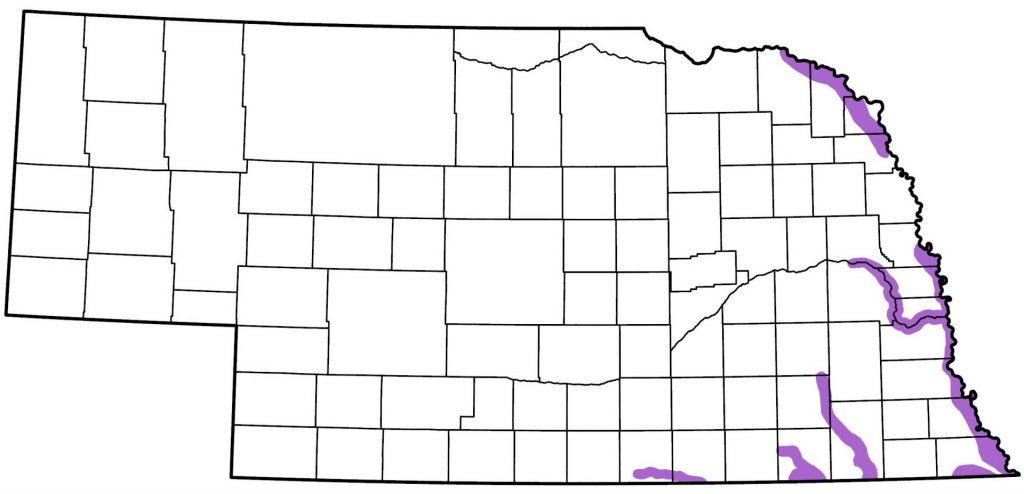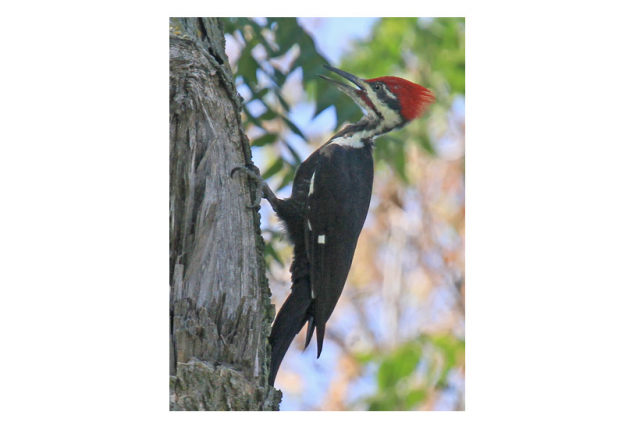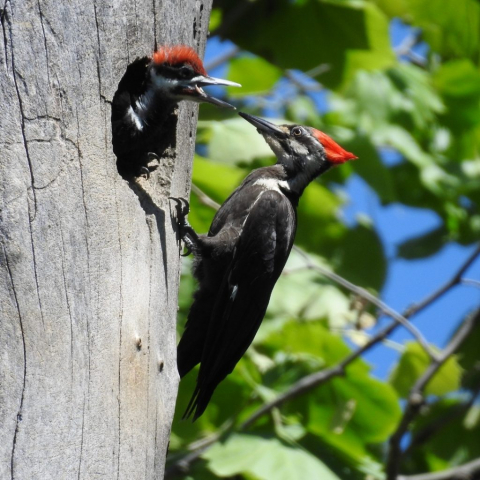Dryocopus pileatus abieticola
Status: Uncommon regular breeder east. Rare casual winter and spring visitor away from east.
Documentation: Photograph: 24 Jan 1991 Bellevue, Sarpy Co (Grenon 1991).
Taxonomy: There are two subspecies recognized (AviList 2025), pileatus, resident south and east of south-central Texas, southeast Kansas, southern Illinois, and Maryland, and abieticola north and northwest of the range of pileatus.
Nebraska birds present prior to extirpation around 1900 were abieticola (Bruner et al 1904, AOU 1957, Rapp et al 1958), and presumably re-establishing birds are also, although there is no evidence either way.
Resident: This species was extirpated from Nebraska prior to 1900; the last report was from near Omaha, Douglas Co 20 May 1895, where it was “formerly not uncommon in the more heavily wooded portions of the Missouri bottoms,” and may have bred (Bruner et al 1904). However, since 1952, when the first recent Nebraska report occurred, the species has re-occupied its former range and expanded beyond its earlier limits. Reports since 1952 are mostly from extensive riparian forest and adjacent upland woodland in the lower Missouri River Valley, north to Washington Co, and, very recently, in the Little and Big Blue River Valleys.
It is likely Pileated Woodpeckers have expanded into Nebraska by moving up different river corridors in the south and east. From northwest Missouri for the Nebraska Missouri River Valley (Robbins and Easterla 1992) and from tributaries of the Kansas River in Kansas for the Little and Big Blue River drainages.
Thompson et al (2011) stated that since the 1960s it has expanded westward in Kansas River tributaries; an early Nebraska sighting of one along the Republican River near Franklin in summer 1974 (Brown 1975) was probably of a dispersing bird from Kansas, as may have been one in Hall Co 13 Mar 1998. Oddly, until 2021 there was no evidence for the presence of Pileated Woodpeckers in the Big and Little Nemaha River Valleys other than an older report of one in a farm woodlot near Cook Feb 1970 (Fiala 1971). This was probably due to lack of suitable habitat in those drainages, which are primarily devoted to row-crop agriculture. In 2021, however, a Pileated Woodpecker was photographed along the Big Nemaha River at Kinter’s Ford WMA in southwestern Richardson Co 15 May, and in 2022, nearby and also in the Big Nemaha River drainage, one was reported at Iron Horse Trail Lake in southeastern Pawnee Co, the first county record.
The first modern report in the Missouri River Valley was of one at a suet feeder near Fort Calhoun 26 Oct 1952 (Rapp 1953). There were two reports 1970-75, an undocumented report of one in Omaha in 1970 (Fiala 1971) and another that came to a suet feeder in Omaha 8 and 10 Feb 1975 (Cortelyou 1975). A series of sightings from Fontenelle Forest occurred 1983-86, possibly involving the same bird. These reports, most undocumented, were in the period 7 Dec-early Jun. Another was seen repeatedly and photographed in Fontenelle Forest 24-27 Mar 1991 (Grenon 1991, Wright 1991).
The first modern documented nesting was of a pair along North Stream Trail in Fontenelle Forest, first seen in the area 25 April 1999 and subsequently seen by many observers; singles had been reported to the south in Fontenelle Forest near Great Marsh 16 Jan, 7 Apr, 18 Apr, and 25 Apr. The activities of the North Stream Trail pair were carefully studied 30 Apr, copulation was observed 4 May, and two young were successfully fledged by 10 Jul. A count of six was made at Fontenelle Forest 4 Jul 2000, and nesting continued in subsequent years; in 2005 nest locations showed that at least two nesting pairs were in the Forest. As of 2015, evidence suggests that Fontenelle Forest may hold three pairs (Rick Schmid, personal communication).
Indian Cave SP, Nemaha and Richardson Cos, is also a consistent breeding location in the Missouri River Valley; although calls and holes attributed to this species were noted 3-4 May 1969 (Tate 1969), no birds were seen. However, in 2002, two birds were seen entering holes in dead trees at the south end of Indian Cave SP 14 May; they were feeding two almost fully-grown young 25-26 May and had left the nest area by 16 Jun (Mollhoff 2004). Reports have continued at Indian Cave SP; a second nest was found 9 Jun 2007 that had three young 16 Jun. As of 2015, there appear to be at least three pairs at Indian Cave SP; 6-8 were counted there 29 Dec 2022.
Between Fontenelle Forest and Indian Cave SP there are regular reports suggesting the species occurs in low densities along the Missouri River Valley in appropriate habitat. A series of sightings of single birds beginning during fall 2002 along the Steamboat Trace trail about 2.5 miles south of the Omaha Public Power Plant in Otoe Co are suggestive of resident birds, but no evidence for breeding has been reported. There are also multiple reports from Washington Co, including the Krimlofski Tract, Neale Woods, Douglas Co, and DeSoto NWR, beginning in 2010, when 1-2 were at DeSoto NWR 24 Apr and Feb 28. N.P. Dodge Park and Hummel Park, both in Douglas Co, have also had several reports, beginning with one at Hummel Park 8 Nov 2006.
In the northeast, records north of Washington Co began in 2018. There were three in 2018, one in 2019, one in 2020, and two in 2021, consolidating range expansion northward; singles, all first county records, were at Ponca SP, Dixon Co 18 Mar 2018, Kramper Lake, Dakota Co 21 Apr 2018, and near Wynot, Cedar Co 1 and 7 Nov 2018. There have been several reports since at Ponca SP with best tally four there during both 21 Aug-17 Sep 2021 and winter 2021-2022. Additional reports near Wynot are 27 Jun 2020, one at Audubon Bend 25 Nov 2023, and one along 889 Road 30 Nov 2023. Two were at Basswood WMA, Dakota Co 18 Feb 2022 and another there 27 Sep 2023.
The only record for the Niobrara River Valley was an amazing sighting at Niobrara Valley Preserve, Brown Co, 17 Apr 2023, followed up by another sighting in the same place 12 Jun (Jeanine Lackey, personal communication). This location is about 150 miles west of Wynot, Cedar Co, next nearest record to the east.
The only records for the Elkhorn River drainage are of one along Maple Creek at Road 13 in Dodge Co 21 Apr 2020 (Don and Janis Paseka, personal communication) and one near Arlington, Washington Co 12 May 2022.
The only record for the Loup River drainage is of one at George D. Syas WMA, Platte Co 28 Jun 2000. A suggestive report was of one seen in early 2017 on the Middle Loup River, near St. Paul, Howard Co; it is possible this bird came from the increasing population in the Little Blue drainage rather than from the Missouri River population.
Expansion westward in the Platte River Valley has been slow. Early reports in the lower Platte River Valley are of one seen near Cris Lake in southeast Sarpy Co during the first week of Jun 1983 (Cortelyou 1983) and one in Sarpy Co 4 Jul 1996. Reports began at Schramm SP, Sarpy Co 23 Mar and 14 May 2016, two were present 5 and 11 Mar 2017, and one was there 12 May 2018 (Don and Jan Paseka, personal communication); since then, reports are 3 Jan 2020, one on 12 Feb and two on 8-16 May 2022. Two were at Bay Hills Golf Course, Cass Co 26 Aug 2024. Singles were at Two Rivers SP, Douglas Co 6 May 2016, 27 Apr 2020, 21 Feb 2022, and Mar-May 2023. Reports in Saunders and Dodge Cos are increasing; bark chipping and removal typical of this species was observed in Saunders Co 18 Dec 2014, and one was in Saunders Co on the Ames CBC 17 Dec 2019, two were at Fremont Lakes SRA, Dodge Co 30 Oct 2016, singles were in Hormel Park, Dodge Co 26 Apr 2020 and 3 Sep 2023, and singles were on the Ames CBC in Dodge Co 21 Dec 2016 and 18 Dec 2024.
Unexpected was one photographed in Howard Co 5 Aug 2023 (Jeff and Tricia Buchanan via Facebook).
There are three records for Lancaster Co: singles in Lincoln 25 Apr 2023, at Wilderness Park 6 May 2022, and at Branched Oak Lake 12 Nov 2023. One was at Lake Wanahoo, Saunders Co 19 Aug 2023.
Reports in the Big Blue River Valley are surprisingly few, especially north of Gage Co, where even there are only about eight records, including resident birds in mature riparian forest along Indian Creek, a few miles north of Beatrice, Gage Co since at least Aug 2016 (Jen Schurman, personal communication). In Saline Co along the Big Blue, the only reports are quite recent, one at Road V near DeWitt 23 Apr 2023, and sightings of two near Big Blue River Lodge in Crete 14-18 May and four, a possible family group, on 15 Jun. The Crete birds had been present since at least Nov 2023 (Sarah Rivers, personal communication) and are the northernmost record in the Big Blue River Valley.
There is a series of reports from the Little Blue River drainage in Jefferson Co, where, as might be expected, initial reports appeared to be of post-breeding dispersers: west of Fairbury 13 and 19 Sep 2011, and two on 15 Nov 2012. Since those reports, it has been reported south of Fairbury along a hike/bike trail and adjacent Flathead WMA, Jefferson Co, a likely breeding location, 4 May 2013, 3 May 2014, 18 Jan 2015, and 5 May 2016 and subsequently. There were four reports at four locations in Jefferson Co in 2022. The westernmost records to date in the Little Blue River Valley are of singles near Hebron, Thayer Co 23 Jun 2014, at Little Blue East WMA, Thayer Co 31 May 2022, 23 Nov 2023, and 31 Mar 2024, and near Meridian WMA, Thayer Co 20 Aug 2022 and 13 May 2023. Farther north and west was one along Big Sandy Creek, Thayer Co 25 Mar 2023.
There are six records for the Republican River Valley. Westernmost was one at Franklin, Franklin Co in summer 1974 (Brown 1975); another was at the same location, the Highway 10 river crossing, 28 Jan 2024. In Webster Co, singles were at Guide Rock Diversion WMA, Webster Co 12 Feb 2022 and 5 Nov 2023, and about 10 miles farther upstream at Indian Creek WMA, Webster Co 29 May 2024 and 13 May 2025. One was in Nuckolls Co 6-17 May 2025.
-
- Breeding Phenology:
Nest-building: 16 Mar- 28 Apr
Copulation: 4 May - Incubation: 12 Apr- 9 May
Nestlings: 23 May- 16 Jun
Fledglings: 18 May-10 Jul
- Breeding Phenology:
Images
Abbreviations
CBC: Christmas Bird Count
NWR: National Wildlife Refuge
SP: State Park
SRA: State Recreation Area
WMA: Wildlife Management Area (State)
Literature Cited
American Ornithologists’ Union [AOU]. 1957. The AOU Check-list of North American birds, 5th ed. Port City Press, Baltimore, Maryland, USA.
AviList Core Team, 2025. AviList: The Global Avian Checklist, v2025. https://doi.org/10.2173/avilist.v2025.
Brown, G.W. 1975. Pileated Woodpecker. NBR 43: 20.
Bruner, L., R.H. Wolcott, and M.H. Swenk. 1904. A preliminary review of the birds of Nebraska, with synopses. Klopp and Bartlett, Omaha, Nebraska, USA.
Cortelyou, R.G. 1975. 1975 (Fiftieth) Spring Migration and Occurrence Report. NBR 43: 46-66.
Cortelyou, R.G. 1983. 1983 (Fifty-eighth) Spring Occurrence Report. NBR 51: 66-78.
Fiala, K.L. 1971. Pileated Woodpecker in Otoe County. NBR 39: 3.
Grenon, A.G. 1991. 1991 (Fourth) Report of the NOU Records Committee. NBR 59: 150-155.
Mollhoff, W.J. 2004. The 2002 Nebraska Nesting Report. NBR 72: 153-158.
Rapp, W.F. Jr. 1953. The Pileated Woodpecker returns to Nebraska. NBR 21: 3-4.
Rapp, W.F. Jr., J.L.C. Rapp, H.E. Baumgarten, and R.A. Moser. 1958. Revised checklist of Nebraska birds. Occasional Papers 5, Nebraska Ornithologists’ Union, Crete, Nebraska, USA.
Robbins, M.B., and D.A. Easterla. 1992. Birds of Missouri, their distribution and abundance. University of Missouri Press, Columbia, Missouri, USA and London, England.
Tate, J., Jr. 1969. Pileated Woodpecker and other birds at Indian Cave State Park. NBR 37: 57-60.
Thompson, M.C., C.A. Ely, B. Gress, C. Otte, S.T. Patti, D. Seibel, and E.A. Young. 2011. Birds of Kansas. University Press of Kansas, Lawrence, Kansas, USA.
Wright, R. 1991. Pileated Woodpecker responds to owl tape. NBR 59: 98-99.
Recommended Citation
Silcock, W.R., and J.G. Jorgensen. 2025. Pileated Woodpecker (Dryocopus pileatus ). In Birds of Nebraska — Online. www.BirdsofNebraska.org
Birds of Nebraska – Online
Updated 1 Aug 2025, map updated 25 Jun 2025


